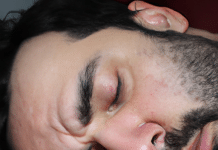CPAP therapy, also known as continuous positive airway pressure therapy, is a common treatment for sleep apnea. It involves the use of a machine that delivers a constant flow of air pressure to keep the airways open during sleep. This article will delve into the ins and outs of CPAP therapy, exploring its mechanism, benefits, and tips for effective use. Whether you’re new to CPAP therapy or curious about how it works, we’ve got you covered. So, let’s dive into the world of CPAP and discover the wonders it can do for a restful night’s sleep.
Review contents
The Basics of CPAP Therapy
Definition of CPAP
CPAP stands for Continuous Positive Airway Pressure. It is a therapy used to treat individuals with sleep apnea, a sleep disorder characterized by pauses in breathing during sleep. CPAP therapy involves delivering a constant and steady flow of air pressure through a machine that is connected to a mask worn over the nose and/or mouth. This helps to keep the airway open and prevent the collapse of the throat muscles that leads to sleep apnea.
Primary goal of CPAP therapy
The primary goal of CPAP therapy is to ensure the consistent and uninterrupted flow of air pressure into the airway, thereby keeping it open and allowing for normal and uninterrupted breathing during sleep. By providing this continuous flow of pressure, CPAP therapy effectively eliminates the pauses in breathing that are characteristic of sleep apnea. This not only improves the quality of sleep, but also provides numerous other health benefits.
Components of CPAP
CPAP machine
At the heart of CPAP therapy is the CPAP machine. This machine is responsible for generating and delivering the air pressure required to keep the airway open. Modern CPAP machines are designed to be compact, lightweight, and quiet, making them easy to use and suitable for a wide range of individuals. It is important to choose a CPAP machine that suits your specific needs and preferences, as there are various models available on the market.
Mask and headgear
The mask and headgear are crucial components of CPAP therapy, as they are responsible for delivering the air pressure from the machine to the airway. There are different types of masks available, including nasal masks, full face masks, and nasal pillow masks. The choice of mask largely depends on personal preference and the comfort level experienced by the individual. The headgear is used to secure the mask in place, ensuring a proper fit and seal.
Tubing and connectors
The tubing and connectors serve as the conduit through which the air pressure is delivered from the CPAP machine to the mask. The tubing is flexible and lightweight, allowing for ease of movement during sleep. It is important to regularly clean and replace the tubing to ensure optimal performance and hygiene. The connectors are used to securely attach the tubing to the CPAP machine and mask, ensuring a tight and leak-free connection.
The Role of the CPAP Machine
Mechanism of the CPAP machine
The CPAP machine works by taking in ambient air and pressurizing it to the prescribed level. The pressurized air is then delivered to the airway through the mask, keeping it open and preventing collapse. This mechanism ensures a continuous flow of air through the airway, eliminating pauses in breathing and promoting regular respiratory function during sleep.
Continuous airflow and pressure
One of the key features of the CPAP machine is its ability to provide a continuous flow of air pressure. This steady and sustained pressure helps to maintain the patency of the airway throughout the night, preventing obstruction and pauses in breathing. The pressure level is determined by a sleep specialist or healthcare provider based on the severity of the sleep apnea and individual requirements.
Humidification
CPAP therapy often includes a built-in or optional humidifier attachment. The purpose of humidification is to add moisture to the air being delivered by the CPAP machine. This helps to prevent dryness and irritation of the airway, a common side effect experienced by some users. By maintaining optimal humidity levels, the CPAP machine ensures comfort and enhances the overall effectiveness of the therapy.
Different Types of Masks
Nasal masks
Nasal masks are the most commonly used type of CPAP mask. They cover the nose and are secured in place using headgear. Nasal masks are popular due to their versatility and comfort. They can accommodate different facial structures and sleep positions, making them suitable for a wide range of individuals. Nasal masks provide a constant stream of air pressure directly into the nostrils, allowing for effective treatment of sleep apnea.
Full face masks
Full face masks cover both the nose and mouth, providing a seal that delivers air pressure to both areas. They are an ideal option for individuals who breathe through their mouth during sleep or experience nasal congestion. Full face masks provide a secure and complete seal, ensuring that the air pressure is effectively delivered to the airway, regardless of the position of the mouth or any oral breathing.
Nasal pillow masks
Nasal pillow masks are the smallest and most lightweight type of CPAP mask. They consist of two small prongs that fit directly into the nostrils, providing an unobstructed view and maximum comfort. Nasal pillow masks are a popular choice for individuals who feel claustrophobic or prefer minimal contact with the face. They offer a high level of freedom and flexibility, allowing for a more natural sleep experience.
Choosing the Right Mask
Considerations for mask selection
When choosing a CPAP mask, there are several factors to consider. Firstly, it is important to determine the type of mask that best suits your needs and preferences. Nasal masks, full face masks, and nasal pillow masks each have their own advantages and disadvantages, so it is essential to find a mask that you feel comfortable using. Additionally, factors such as mask fit, size, and adjustment options should be taken into consideration.
Size and fit
The size and fit of the mask are crucial for its effectiveness. A well-fitting mask ensures a proper seal, allowing the air pressure to be delivered effectively. Most masks come in a range of sizes, and it is important to choose the size that best matches your facial structure. Some masks also offer adjustable features, such as straps and cushions, which can be customized to provide a snug and comfortable fit.
Comfort and seal
The comfort of the mask is an important consideration, as it directly impacts the overall experience of CPAP therapy. A comfortable mask ensures that you are able to sleep without any discomfort or irritation. It is essential to choose a mask that does not impede your ability to sleep in your preferred position or cause any pressure points on the face. Additionally, the mask should provide a proper seal to avoid any air leaks that can compromise the effectiveness of the therapy.
Setting Up the CPAP Machine
Proper machine placement
Proper machine placement is crucial for effective CPAP therapy. The machine should be placed on a stable surface, such as a nightstand or bedside table, within reach. It should be positioned below the level of your head, as this allows for gravity to assist in the proper flow of air pressure. The machine should be plugged into a power source and connected to the tubing and mask.
Connecting the mask and tubing
To set up the CPAP machine, the mask and tubing need to be securely connected. The tubing should be firmly attached to the machine’s air outlet, while the other end should be connected to the mask. It is important to ensure that the connections are tight and leak-free, as any air leaks can compromise the effectiveness of the therapy. Once the mask and tubing are connected, the machine can be powered on.
Adjusting the settings
CPAP machines offer various settings that can be adjusted to meet individual needs and preferences. These settings include the pressure level, ramp time, and humidity level (if applicable). It is important to consult with a healthcare professional or sleep specialist to determine the optimal settings for your specific condition. Once the settings are adjusted, the CPAP machine is ready to be used for a restful night’s sleep.
Using CPAP During Sleep
Finding a suitable sleeping position
Finding a suitable sleeping position is important for maximizing the effectiveness of CPAP therapy. It is recommended to sleep on your back or side, as these positions allow for better airway alignment and reduce the risk of air leaks. Elevating the head with pillows can also help to maintain an optimal sleeping position. Additionally, it is important to avoid sleeping in positions that can obstruct the mask or tubing, such as lying on the stomach.
Maintaining a proper seal
Maintaining a proper seal between the mask and the face is essential for effective CPAP therapy. A loose or improper seal can result in air leaks, reducing the effectiveness of the therapy and causing discomfort. It is important to adjust the headgear and straps to ensure a snug fit without excessive tightness. Regularly checking and adjusting the seal throughout the night can help to maintain optimal therapy.
Maintaining a consistent routine
Consistency is key when it comes to CPAP therapy. It is important to use the CPAP machine every night, even when traveling or during daytime naps if recommended by a healthcare professional. By maintaining a consistent routine, the body becomes accustomed to the therapy, making it easier to adjust and ensuring the maximum benefits are obtained. It may take some time to adapt to using CPAP, but with patience and persistence, it can become a seamless part of the sleep routine.
Benefits of CPAP Therapy
Improved sleep quality
One of the primary benefits of CPAP therapy is the improvement in sleep quality. By ensuring uninterrupted breathing throughout the night, CPAP therapy helps to promote deep and restful sleep. Individuals who suffer from sleep apnea often experience frequent awakenings and restless sleep due to the pauses in breathing. CPAP therapy effectively eliminates these interruptions, allowing for more satisfying and rejuvenating sleep.
Reduced daytime sleepiness
Sleep apnea can cause excessive daytime sleepiness and fatigue due to poor sleep quality. CPAP therapy helps to alleviate these symptoms by ensuring a restful night’s sleep. With regular use of CPAP, individuals often experience a significant reduction in daytime sleepiness, allowing for increased productivity, improved concentration, and enhanced overall well-being.
Better overall health
CPAP therapy has been shown to offer numerous health benefits beyond improved sleep quality. By effectively treating sleep apnea, CPAP therapy helps to reduce the risk of associated health conditions, such as high blood pressure, heart disease, and stroke. It also helps to regulate oxygen levels in the blood, promote healthy lung function, and improve overall respiratory health. Using CPAP consistently can have a positive impact on long-term health outcomes.
Potential Side Effects and Solutions
Nasal congestion and dryness
Some individuals may experience nasal congestion and dryness as a side effect of CPAP therapy. This can be caused by the constant flow of air through the airway. To alleviate these symptoms, it is recommended to use a heated humidifier with the CPAP machine. The humidifier adds moisture to the air, reducing nasal dryness and congestion. Nasal saline sprays or nasal irrigations can also be helpful in keeping the nasal passages moist.
Skin irritation and pressure sores
Wearing a mask for extended periods of time can sometimes cause skin irritation and pressure sores. To prevent these issues, it is important to ensure that the mask is clean and properly fitted. Regularly cleaning the mask and replacing any worn-out components can help to prevent skin irritation. Additionally, using padding or silicone gel pads can provide extra cushioning and alleviate pressure on the skin.
Claustrophobia and discomfort
Some individuals may experience feelings of claustrophobia or discomfort when using CPAP. It is important to remember that these reactions are not uncommon and can be overcome with time and practice. Gradual acclimatization to wearing the mask during waking hours, practicing relaxation techniques, and seeking support from healthcare professionals or support groups can help to address feelings of claustrophobia or discomfort. Customizing the mask fit and considering alternative mask options can also make the experience more comfortable.
Monitoring and Maintenance
Regular usage tracking
Monitoring the usage of CPAP therapy is important for ensuring its effectiveness. Many CPAP machines come with built-in usage tracking features that record the duration and quality of therapy sessions. Regularly reviewing the data can help to identify any issues or patterns that may require attention. This information can be shared with healthcare professionals to make any necessary adjustments or modifications to the therapy.
Machine maintenance and hygiene
Proper maintenance and hygiene of the CPAP machine are essential for optimal performance. This includes regularly cleaning and disinfecting the mask, tubing, and humidifier (if applicable). It is important to follow the manufacturer’s instructions for cleaning and replacing the components. Additionally, it is advisable to regularly inspect the machine for any signs of wear or dysfunction and seek professional assistance for repairs or replacements when needed.
Replacing components
Over time, the components of the CPAP machine may wear out and require replacement. This includes the mask, headgear, tubing, and filters. It is important to regularly inspect these components for any signs of deterioration or damage and replace them as needed. In general, masks should be replaced every 6-12 months to ensure a proper fit and seal. Following the recommended replacement schedule will help to maintain the effectiveness and longevity of the CPAP therapy.
In conclusion, CPAP therapy is an effective treatment for sleep apnea, ensuring a consistent and uninterrupted flow of air pressure to keep the airway open during sleep. The CPAP machine, mask, and tubing are important components of the therapy, working together to provide effective treatment. It is crucial to choose the right mask, ensure a proper fit, and maintain a consistent routine to maximize the benefits of CPAP therapy. While potential side effects may occur, they can be addressed and managed with appropriate solutions. Regular monitoring, maintenance, and replacement of components are essential for long-term success with CPAP therapy. Overall, CPAP therapy offers numerous benefits, from improved sleep quality to better overall health, and can significantly enhance the well-being of individuals with sleep apnea.



























